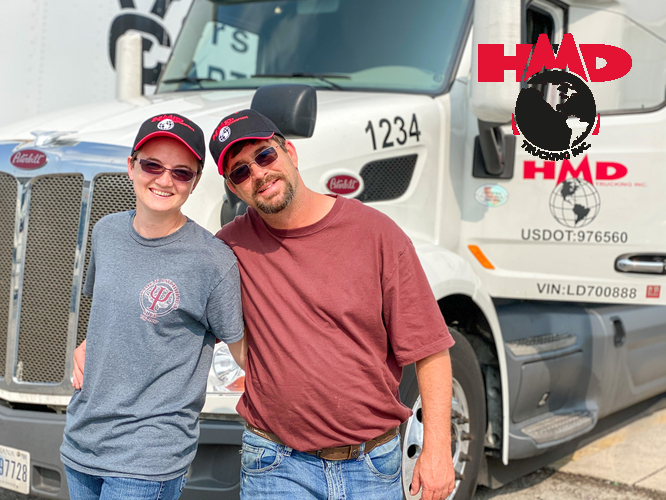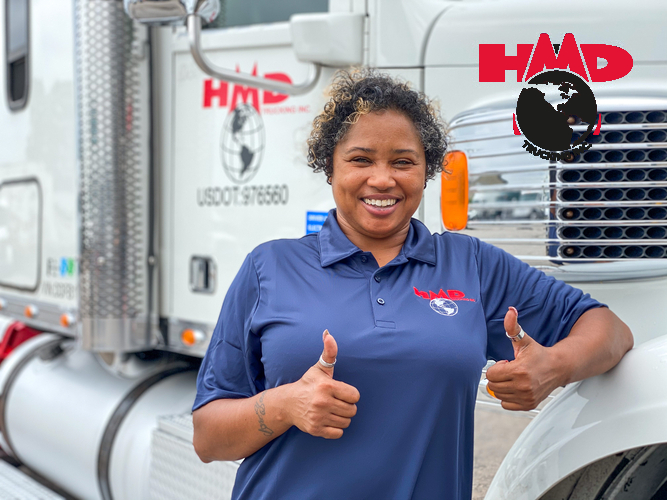Trucking is an industry that offers several driving opportunities for drivers who want to haul loads from one destination to another. But regardless of your preferred trailer type, route, and company, you can either ride solo or work as a team.
Although the idea of riding with someone else sounds fun, considering you’ll always have company in the cab, the reality is different because every driver has unique character traits.
So, this article will discuss the benefits and drawbacks of team truck driving, as well as explore how it works.
Contents:
- How Does Team Truck Driving Work?
- Questions to Ask Yourself Before Becoming a Team Truck Driver
- Challenges of Team Truck Driving
- Benefits of Team Truck Driving
- How Much Do Team Truck Drivers Make?
- Tips for Improving Team Driving Work
- Team Driving Hours of Service Rules
- Conclusion
How Does Team Truck Driving Work?

Driving as a team involves taking turns in the driver’s seat with your chosen team member. When you are behind the wheel, your partner can go to sleep, and vice versa. This format will help you and your partner cover more miles, thereby increasing your earning potential.
The majority of team drivers partner with their wives or husbands or friends because it is more convenient than working alongside a complete stranger. But since the probability of becoming a trucker alongside your spouse is limited, you may end up working with a colleague — whether you like the person or not.
Questions to Ask Yourself Before Becoming a Team Truck Driver

Most truckers hop into cabs with colleagues because they want to earn more money or gain OTR experience. Although these are valid reasons to drive as a team, you need to consider some challenges that come with this opportunity.
Do You Love Your Space?
Driving in a team means that you have to share a small space with someone else for long stretches of time. Both of you will share the same cabin and sleep compartments. So think about what your personal space means to you before teaming up with someone.
Is Your Partner Trustworthy?
You also need to consider if your potential partner is trustworthy. If you have the ability to choose, look for someone who shares the same personal and professional values.
You won’t always have the opportunity to cherry-pick your driving partner since some carriers match drivers randomly. But the good news is, with modern AI-powered matching algorithms, modern carriers now pair drivers based on compatibility and personal track records.
Are You Willing to Compromise?
Your willingness to compromise on your hardline rules and values determines your fitness to become a team truck driver.
Think about it: your active hours will be your partner’s sleeping hours. If you can’t drive a truck without loud music, you have to be ready to give up some hours of music to help your partner sleep.
Also, you might end up in a truck with a driver who takes several bathroom breaks. Instead of cursing under your breath any time they request a stop, prepare to meet them halfway with respect to their needs (as they may very well be meeting you halfway with yours).
Why Are You Doing This?
Truckers team up for two main reasons: to earn more money or to gain experience from seasoned drivers.
If you are teaming to earn more cash, you need to focus on loads with a longer route or a higher CPM (cents per mile).
If you are hoping to get more experience as a truck driver before applying for higher-paying jobs with your CDL, teaming up with a willing teacher and mentor will help you learn how to optimize procedures to earn more.
So, establish your “ultimate why” and start looking for partners who fit this bill. And most importantly, consider if the extra money is worth the potential of additional hassle. If yes, then hop on and start driving as a team.
Challenges of Team Truck Driving

It Gets Lonely
A team company driver is not alone on paper, but if you land a partner who is your polar opposite in everything, you might as well be alone in the truck. Or, simply, your fellow driver might just want to keep things professional. So, in reality, you only end up exchanging greetings when switching places.
You Don’t Have Complete Control
The first thing you lose full control of is any “auxiliary” tech — in other words, you can’t sing your lungs out to your favorite AC/DC album as you sprint down the highway toward delivering your load. Every decision you make has to factor in your partner’s approval, and this can get frustrating and even confrontational during trips.
Quality of Sleep
Yes, you will get to sleep while the other driver takes the wheel, but the quality of sleep may just not be the same. Apart from the possibility of constant music in the truck cab, you still have to deal with what may be less-than-ideal conditions in the sleeper. And you can’t tell your partner to turn off the radio if you had yours cranked during their sleep.
Another factor that will affect your sleep quality is the road. Bumps, potholes, and bad roads will jolt you back to reality, disrupting your peaceful sleep. And vibrations from the truck will produce a persistent humming sound that newbie team truckers might find annoying.
Stopping for Breaks
When you are riding solo, you can time your breaks to fit into the originally planned route. But when you have a partner on board, you’ll have to make additional stops.
You May Not Like Your Driving Partner
Confrontations and power struggles are no stranger to team trucking. If you are not willing to compromise to accommodate your partner’s needs, you will end up arguing and brewing animosity.
You’ll Spend a Long Time Away From Home
Team truck driving involves multiple shifts between two drivers, which means you’ll get to spend a longer time on the road. This usually affects OTR team drivers more.
Benefits of Team Truck Driving

Now that you know the challenges of team truck driving, let’s explore the potential benefits of driving with someone else.
You Are Never Alone
Trucking is a lonely profession that confines you to your cab, flanked by a radio, an audiobook, or some music. But if you want the company of another human, preferably a spouse or buddy, then you will enjoy teaming up.
Apart from keeping you company, your partner will also help you load and unload the cargo. You’ll also take turns inspecting and weighing the load.
You Can Get More Trucking Jobs
Most truck drivers take solo jobs at the start of their careers. Although you can forge a career path with top carriers as a solo operator, becoming a team driver opens you up to more trucking jobs.
You’ll Earn More
Team truck driving jobs often pay more than solo gigs because two drivers can travel further distances than one person. So if you can stomach the differences and challenges of sharing the cab with someone else, you will reap the rewards in extra CPMs.
We’ll discuss the average team truck driver salary in more detail later.
You Can Ride With Your Spouse
We’ve already discussed how teaming up helps you get rid of loneliness, but nothing beats being on the road with your spouse. Both of you can enjoy fun activities together. You can work out, discuss important life issues, and visit exciting places as a couple.
Since 13.6% of truckers suffer from some form of depression, having family next to you will help you cope during tough times. You could also chronicle your journey like the Trucking Couple.
It Is Efficient and Secure
When you are a team company driver, you and your partner will complete trips faster without breaking the FMCSA (Federal Motor Carrier Safety Administration) regulations. More on that later.
Also, having a partner with you provides an extra level of security, especially for female truckers. And in case of medical emergencies, your partner can come to the rescue with first aid before calling 911.
How Much Do Team Truck Drivers Make?

Team truck driving pays more than solo operations on average because you'll be delivering your freight in half the time it would typically take.
For partnerships consisting of two drivers, the team drivers pay per mile typically ranges from $0.75 to $0.90, split between the team. According to Salary.com, the annual team truck drivers' salaries generally fall between $67,845 and $82,019. However, ZipRecruiter.com presents a more appealing figure, estimating an average of $90,312 per year. As of January 2024, the highest compensation - $105,542 - for team truck drivers is provided by employers in Washington, DC.
Explore our articles to learn more about the average salaries of truck drivers in the USA, including specific details on flatbed and OTR driver earnings.
At HMD Trucking, OTR team drivers make 77 CPM plus 5 CPM as a safety/productivity bonus. But teams can haul hazmat/doubles loads if they are endorsed and get an additional 4 CPM as well.
The average weekly miles is about 4500 to 5000, which results in $4,000 - $4,200 per team. When combined with the $10,000 sign-on bonus, this makes earning between $190K - $210K per year more than realistic.
Good news! We’ve just added a team position to our Flatbed division. We offer 77 CPM base plus 5 CPM as a safety/productivity bonus. And well-maintained Pete 567 and a load is still in place. Read the following article to learn about the pros and cons of flatbed trucking.
Tips for Improving Team Driving Work

Here are expert tips from people who have done several team truck driver jobs.
Create a Communication System
Drivers who don’t get along well should create a system to communicate with their mates. For example, you can hang a towel on the dashboard to signal that you are out of the truck. Yes, it sounds ridiculous, but the last thing you want is to have to hitch a ride in order to catch up with the truck.
Be Considerate When Your Partner Is Sleeping
Driving in absolute silence can be deafening, but at the same time, you can’t turn the music all the way up when your partner is asleep. So you have to find the middle ground and use common empathy to find an acceptable volume that suits everyone.
See Local Sights
During your breaks, you can visit local sights to decompress. Reach out to your partner to see if they are also interested in visiting places within the city or countryside. This activity could turn out to be a bonding exercise for both of you.
Do Everything Together
While on the road, don’t let your animosity cloud your sense of judgment and professionalism. Both drivers have to be in sync when loading, unloading, reversing, and navigating, because one error from the person behind the wheel can put you both in an unsafe set of circumstances quickly.
Team Driving Hours of Service Rules

As mentioned earlier, the FMCSA places a cap on the number of hours individual drivers can spend on the road. Here are some noteworthy team driving hours of service rules:
- Every team driver must have at least 10 hours off between trips.
- Drivers have an 11-hour driving limit after 10 consecutive hours off duty.
- Team drivers may not drive beyond the 14th consecutive hour after coming on duty, following 10 consecutive hours off duty.
- Drivers must take a 30-minute break when they have driven for a period of 8 cumulative hours without at least a 30-minute interruption.
- Drivers may not drive after 60-70 hours on duty in 7-8 consecutive days.
- A driver must take 34 or more consecutive hours off duty before restarting a 7-8 consecutive day period.
- Drivers may split their required 10-hour off-duty period as long as one off-duty period (whether in or out of the sleeper berth) is at least 2 hours long, and the other involves at least 7 consecutive hours spent in the sleeper berth.
- All sleeper berth pairings must add up to at least 10 hours. When used together, neither time period counts against the maximum 14- hour driving window.
- You may extend the 11-hour maximum driving limit and 14-hour driving window by up to 2 hours in cases of adverse driving conditions.
- For short haulers operating larger or heavier vehicles below 26,000 lbs, drivers can now increase their maximum on‑duty period from 12 to 14 hours and extend the short haul radius from 100 air miles to 150 air miles.
You can read all the hour of service (HOS) regulations about DOT hours here.
Conclusion
Team trucking is a fun experience that can help you get more employment opportunities in a truck driver jobs. You can also earn a higher pay per mile over the same route. But to succeed as a team trucker, you need to learn how to collaborate and coexist with your partner. You also need to respect and empathize with the person transporting freight with you.
If you want to work with a company that cares about the driver’s overall health and wellbeing, HMD Trucking is the place for you. Our personalized approach to trucking makes us the favorite destination for drivers (with at least 6 months of CDL A experience). Apply with us now to start your trucking adventure.


